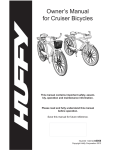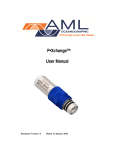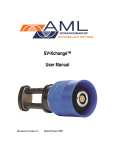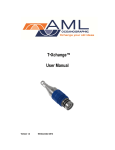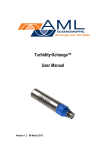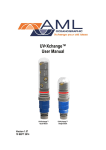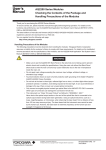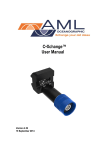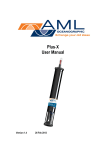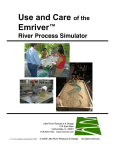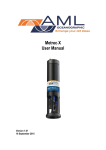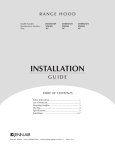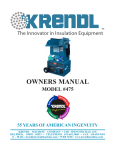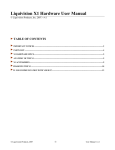Download Cabled UV - User Manual
Transcript
Cabled UV Biofouling Control User Manual Version 1.17 09/07/15 For use with models: PDC-CUV-V-05-3m (shown) PDC-CUV-H-05-3m PDC-CUV-CUSTOM-05-3m User Manual for AML Oceanographic’s Cabled UV Biofouling Control Revision History Revision Date Description Author 1.0 7 May 2014 Document created. Q.C. 1.1 18 August 2014 Formatting edits J.Z. 1.15 12 September 2014 Formatting edits J.Z. 1.16 28 April 2015 Added new GLS codes J.Z. 1.17 9 July 2015 Updated ordering codes J.Z. 1 User Manual for AML Oceanographic’s Cabled UV Biofouling Control Table of Contents General Description ....................................................................................................................3 Where Do I Start? .......................................................................................................................4 Shipping and Receiving ..............................................................................................................5 Receiving the Product .............................................................................................................5 Returning a Product to the Factory .........................................................................................5 Using the Product........................................................................................................................6 Safety .....................................................................................................................................6 Pressure Rating ......................................................................................................................6 Adding/Removing the Quartz Tube .........................................................................................6 Adding/Removing LED Modules .............................................................................................7 Angular Alignment of LED Modules ........................................................................................8 Mounting .................................................................................................................................8 Installing the Product ..............................................................................................................9 Removing the Product ..........................................................................................................10 Duty Cycle Selection and Specification.................................................................................10 What should the duty cycle be? ......................................................................................10 How is the duty cycle controlled? ....................................................................................10 UV Bulb Life ..........................................................................................................................10 Maintaining the Product ............................................................................................................11 Inspecting and Replacing the O-rings ...................................................................................11 Close-up of how to properly remove exterior O-rings from a device .........................................11 Technical Specifications ............................................................................................................12 LED Module Emission Pattern, Irradiance and Dosage ............................................................13 Support .....................................................................................................................................16 Troubleshooting ....................................................................................................................16 Frequently Asked Questions .................................................................................................16 Contact AML Oceanographic ................................................................................................17 Ordering Codes .........................................................................................................................18 Warranty ...................................................................................................................................19 Technical Overview Drawings ...................................................................................................20 2 User Manual for AML Oceanographic’s Cabled UV Biofouling Control General Description Cabled UV Biofouling Control is a modular antifouling system designed to protect equipment during in-situ deployments. It uses ultraviolet light to prevent algae and other colonizing microorganisms from growing on target surfaces. By preventing initial colonization, the protected surfaces remain clear of larger, later-stage organisms such as barnacles and sea grass. Ultraviolet light is emitted by individual UV LED modules housed within a quartz tube. Target surfaces are protected by fixing Cabled UV in proximity such that the surfaces are irradiated by the emitted UV light. Cabled UV is configurable for a variety of different applications. The UV LED Modules are stackable such that up to four modules may be installed, each with a unique radial orientation. This allows multiple surfaces to be protected by one Cabled UV, or multiple LED Modules irradiating a common surface. Various removable glass tube lengths are available to accommodate different LED module stack heights. The LED modules are free to rotate a full 360° before being fixed in position via a setscrew opposite the LED. In general: modules may be removed or added; modules are free to rotate a full 360°; side-facing modules are invertible - allowing positive and negative pitch angles; rod height can be adjusted by adding or removing rods (from a single module up to a four module stack) Cabled UV and UV LED modules are distinguishable by their unique serial numbers - 830000 series and 850000 series respectively. Each module is also labeled with its optical power, and pitch angle. UV emission is controlled by modulating power to Cabled UV. In typical deployments, UV light is controlled via a duty cycle which consists of alternating periods of “on” and “off.” This duty cycle is controlled by one of the following two methods: Locking Collar Quartz Tube UV LED Module (Upward facing model shown) Stackable Rod (Terminating Rod shown) Stem 3 m cable with SubConn Micro 6 male connector 1. AML’s Duty Cycle Controller, available as a standalone OEM board (AML part number SUB-G0749), or housed in a submersible housing that is installed in-line with Cabled UV (PDC-DCC-05). 2. Customer-provided power control to Cabled UV. 3 User Manual for AML Oceanographic’s Cabled UV Biofouling Control For instructions on the use of the Duty Cycle Controller (PDC-DCC-05), please refer to its respective user manual. Close-up of the UV LED module engraving showing serial number, pitch angle, and optical power. Downward (negative) pitch orientation of horizontal module (right) is visible. Where Do I Start? If you are performing instrument maintenance or require more information on the use of Cabled UV Biofouling Control, begin with this manual. If you are setting or changing the duty cycle and are using an AML Duty Cycle Controller, begin with its respective manual. 4 User Manual for AML Oceanographic’s Cabled UV Biofouling Control Shipping and Receiving Receiving the Product When receiving a new Cabled UV Biofouling Control device, perform the following steps to ensure the product will be ready for deployment when required: Inspect the shipping container, looking for signs of damage. Damage to the shipping container could indicate damage to the product inside. Inspect for damage o Check the housing for cracks or bends o Check the quartz tube for cracks or chips o Check the internal components for damage o Check the connector for corrosion, dirt, and salt deposits Returning a Product to the Factory If shipping for repair, obtain an RMA number from the service centre. Pack the product in its original shipping box to prevent damage during shipping. An RMA number can be requested using the contact options given in the Support section of this manual. 5 User Manual for AML Oceanographic’s Cabled UV Biofouling Control Using the Product Safety This product produces UVC radiation, which can cause damage to eyes and skin. When working near UV light the following precautions are recommended: Wear UV-rated safety glasses If users will be exposed to UV light for a prolonged period of time (over 1 minute), wear long sleeves, gloves, and a UV resistant face shield to protect skin and eyes Place shields around the UV light source to limit the area of exposure In general, the above precautions are only necessary when Cabled UV is powered out of water where light will travel much farther. Best practice is to install and align Cabled UV while the device is off (unpowered), as outlined in the Installing the Product section of this manual. Pressure Rating Cabled UV Biofouling Control™ is rated to operate to a maximum depth of 500 m [1,640 ft]. Adding/Removing the Quartz Tube To access the LED module(s), the quartz tube must first be removed. This must be performed while Cabled UV is in air and is dry. Do not remove the quartz tube while the instrument is wet. To remove the quartz tube, grip the stem with one hand and turn the blue plastic collar counterclockwise with your other hand. Carefully remove the blue collar. The air contained within the quartz tube may be slightly above atmospheric pressure, which can cause the tube to slide past the lower sealing O-ring when the blue collar is removed. To remove the quartz tube, again grip the stem with one hand and the quartz tube in your other hand and carefully separate it from the stem. The quartz tube is installed in the reverse manner. 6 User Manual for AML Oceanographic’s Cabled UV Biofouling Control Stabilizing O-ring Silicone Washer Sealing O-rings Stem Before installing the quartz tube, ensure that it is free of cracks and chips. The silicone washer acts as a bearing surface for the tube while pressurized, so it must also be flat and free of debris. Trapping debris between the quartz tube and the seat may result in failure of the quartz tube under pressure. O-ring maintenance and replacement procedures are outlined later in Inspecting and Replacing the O-rings. Adding/Removing LED Modules Cabled UV allows for the addition or removal of LED modules such that one to four modules may be installed, each with a unique axial orientation. General rules of operation: There will always be the same number of rods as modules. To remove only the uppermost rod, it is necessary to grip the flat with a wrench on the rod below it. Use a 5/32 hex to screw rod into position. This feature is shown in the following figure. LED modules are fixed in position by setscrews. Loosening the setscrew allows them to slide freely along the central rod, or rotate freely around the central rod. Once aligned, tighten the bottom module first, followed by those at higher stack levels. To adjust a module, you will need to loosen its setscrew and the setscrew of all modules above it. Side-facing modules are reversible, that is, they have contact pads on both sides. This allows for two different pitch orientations of the LED. Never attempt to rotate an LED module without first loosening the set screw. A 78° LED module must only be fastened to a Terminating Rod, while a 13° LED module must only be fastened to a Central Rod. These components are shown below. 7 User Manual for AML Oceanographic’s Cabled UV Biofouling Control 78° LED module (upward facing) Terminating Rod Wrench Flat 13° LED module (sideways facing) Central Rod Angular Alignment of LED Modules The LED modules may be rotated freely such that LEDs may be aligned to any angle. General rules for module alignment are listed below: Modules can be rotated freely once the setscrew has been sufficiently loosened on the module of interest, and on all those modules at higher stack levels. Module alignment can be performed by eye by pointing the LED at the target surface. Because the LED beam pattern is broad, greater than 70° when in water, alignment does not have to be exact. Refer to LED Module Emission Pattern and Irradiance later in this manual for more details. Push down on a module while tightening the setscrew. When tightening multiple modules, always start with the bottom or lowest stack level, and then work up. Mounting Cabled UV may be fixed in place by clamping its dedicated mounting surface, located directly adjacent to the product label as identified below. DO NOT clamp anywhere else on the device. Clamping surface 8 User Manual for AML Oceanographic’s Cabled UV Biofouling Control Cabled UV may be clamped by using its optional mounting bracket, sold separately. To install AML’s mounting bracket (MBR-CUV-STD) for Cabled UV: 1. Ensure the clamping surface is clean on both the clamp and Cabled UV. 2. Loosen the clamp fastener with a 7/64” Hex Key. 3. Slide the 6 pin male connector of Cabled UV through the centre of the clamp and position the clamp in the middle of the mounting surface outlined above. 4. Fasten the clamp to the stem of Cabled UV with a 7/64” Hex Key. Orientation at this step is not crucial, as it can be adjusted once attached to the sensor/device. Refer to the Technical Overview Drawing at the end of this manual for detailed mounting dimensions. Installing the Product The exact process of installation will be application specific. A general procedure for all installations typically consists of mounting the device adjacent to target surfaces, then orienting the individual LED module(s) such that the surfaces will be irradiated during device operation. In more detail, the procedure is generally as follows: 1. Remove the power source to Cabled UV. 2. Mount the device in a location close to the surface(s) to be protected. The exact mounting arrangement will be application-specific. For optimal biofouling protection, ensure that the distance between the UV LEDs and the target surface is no more than 10 cm [4.0 in] away and that the incident angle is as close to 90o as practical. More details on the emission patterns for the LED Modules are provided in LED Module Emission Pattern, Irradiance and Dosage, discussed later in this manual. Approximate UV beam spread in seawater. Cabled UV device with single upwards facing module shown left (PDC-CUV-V-05-3m), and single sideways facing module shown right (PDC-CUV-H-05-3m). 9 User Manual for AML Oceanographic’s Cabled UV Biofouling Control 2a. If the LED module requires further alignment, remove the quartz tube and adjust the module’s orientation, as discussed in Adding/Removing the Quartz Tube and Angular Alignment of LED Modules. 3. If controlling Cabled UV via the Duty Cycle Controller, connect the male 6-pin connector of Cabled UV to the female connector of the DCC. 4. Confirm correct LED Module orientation. This can be done by fixing standard white-carbon paper (such as standard printer paper) to the target surface and powering Cabled UV. The incidental UV emission will be observable as the paper will fluoresce. Note that the UV beam spread in air is wider than in seawater: approximately 120o vs 70o, respectively. Removing the Product If the product has been used in salt water, rinse it in fresh water. Dry the product before removal to protect the connector. Unscrew the black locking sleeve. Holding the cable at the connector, pull to remove it from the power/timing source Duty Cycle Selection and Specification What should the duty cycle be? Selecting the correct duty cycle is key to optimizing the effectiveness of the product while minimizing power consumption. High duty cycles (50% or greater) provide more biofouling protection for deployments in environments with aggressive fouling but also results in increased power consumption. Alternatively, less aggressive fouling environments may allow for a reduced duty cycle, resulting in reduced power consumption. It is not possible to recommend one duty cycle that is appropriate for all deployments due the wide array of factors such as available power, aggressiveness of fouling in the environment, water turbidity, seasonal variation, depth, etc. With these factors in mind, AML Oceanographic generally recommends a duty cycle of 50%, consisting of 20 minutes on, 20 minutes off. This duty cycle has been shown to be effective in aggressive biofouling environments: tropical locations, shallow depth, high insolation deployments, etc. Increasing or decreasing the duty cycle may be appropriate however, at the discretion of the user. How is the duty cycle controlled? The duty cycle is controlled by modulating power to Cabled UV. For instructions on how to set up the duty cycle when using AML’s Duty Cycle Controller, please refer to its respective manual. UV Bulb Life The specified life of the UV LEDs is such that they diminish to 50% of their original power after 5,000 hours of total cumulative operational time. It should be noted that the LEDs will still operate at this time and that the reduction in intensity can be compensated for by increasing the duty cycle. It is recommended that the LED modules be replaced after 5,000 hours of operation. Refer to Ordering Codes for ordering information. 10 User Manual for AML Oceanographic’s Cabled UV Biofouling Control Maintaining the Product Inspecting and Replacing the O-rings WARNING: Cabled UV uses Ethylene Propylene Diene Monomer (EPDM) O-rings. When replacing O-rings on Cabled UV, ensure they are made of EPDM rubber. Incident UV light will cause Buna Nitrile (Buna-N) and other standard O-rings to deteriorate, eventually resulting in failure of the product. It is crucial to keep the O-rings clean and greased. Any fibres or dirt on the O-rings will allow water into the connector or into the housing. To gain access to the O-rings, perform the following steps: Remove the quartz tube, as previously outlined in Adding/Removing the Quartz Tube. Inspect the O-rings for dirt. Clean and reapply standard silicone grease, if necessary. Inspect the O-rings for nicks and cracks. If any are found, the O-rings must be replaced. Apply silicone grease to the new O-rings before using them. Caution: Do not use a sharp instrument to remove the O-rings. If the O-ring grooves are scratched, the O-rings will not provide a waterproof seal. The O-rings can be removed easily with bare hands as shown below. Close-up of how to properly remove exterior O-rings from a device 11 User Manual for AML Oceanographic’s Cabled UV Biofouling Control Technical Specifications Power Consumption Quantity of 3mW Modules 1 2 3 4 Total Current Draw [mA] 120 208 296 384 UV LED Modules Side Facing 120o 70o 3 mW - 5 to +55oC +/- 13o Viewing Angle (in air) Viewing Angle (in water) Optical Power Operating Temperature Range Pitch (angle from horizontal) Instrument Tube Material Stem Material Depth Rating Cable Length Operating Voltage Electrical Connector Quartz Ultem 500 m [1,640 ft] 3 m [9.8 ft] 12-26 VDC MCIL6M 12 Upward Facing 120o 70o 3 mW -5 to +55oC 78o User Manual for AML Oceanographic’s Cabled UV Biofouling Control LED Module Emission Pattern, Irradiance and Dosage The following plots show the irradiance field of a 3 mW UV LED module in sea water at 0 NTU. A minimum irradiance of 10 µW/cm2 at a 20 minute on/20 minute off duty cycle is recommended to keep a target surface clear of biofouling. This minimum irradiance threshold is highlighted in red in the figure below. General best practice is to ensure that the target surface is within approximately 10 cm [4 in] for effective biofouling control. The following plots represent the intensity of the UV light. Contact AML Oceanographic to discuss optimal settings for your application. Irradiance field and 10 µW/cm2 threshold of a 13° 3 mW LED module oriented with negative pitch in sea water at 0 NTU. Side view and top view on the left and right, respectively. 13 User Manual for AML Oceanographic’s Cabled UV Biofouling Control Irradiance field and 10 µW/cm2 threshold of a 78° 3 mW LED module in sea water at 0 NTU. Side view and back view on the left and right, respectively. 14 User Manual for AML Oceanographic’s Cabled UV Biofouling Control Irradiance level along the centre line of trajectory for a 3 mW UV LED module in sea water at 0 NTU 15 User Manual for AML Oceanographic’s Cabled UV Biofouling Control Support Troubleshooting LEDs fail to turn on: UV LED operation may be confirmed through fluorescence, standard carbon printer paper will fluoresce blue/purple when held within the beam path of an UV LED module. Is the timing/power circuit supplying 12-26VDC? Is timing/power circuit pinout correct? See Page 3 of the document Cabled UV Biofouling Control – Customer Overview Drawing Is the Subconn Micro6 connector connection dirty or corroded? Clean using electrical contact cleaner. Is the UV LED module receiving power? Check to make sure there is a 12 V potential between the inner and outer rings on the PCB that contacts the UV LED module pins. Are the electrical pins on the bottom of the LED Module making contact with the PCB? Try loosening the UV LED module’s setscrew and re-tighten the module. See Angular Alignment of LED Modules for proper UV LED module installation steps. Frequently Asked Questions Can LED modules be stacked upside down? Yes. The 13o modules are designed to operate in either orientation (LED facing up or down). This allows the system to accommodate a wide range of configurations. Can you stack just three modules in a multi-module housing? There is no minimum number of LED modules that must be present. It is acceptable to have between one and four in a multi-module quartz housing, in any orientation. How can I tell if my LED modules are working? Although it is not possible to directly observe the UV light as it is beyond the visual range of the human eye, ordinary white paper will fluoresce under UV light. Holding a strip of white paper in front of an LED module will indicate that the LED is working as the paper will fluoresce a deep blue. Note that caution should be exercised to avoid irradiating exposed skin. How long will my LED modules last? The rated life of the LEDs is 5,000 hours of total cumulative operational time. This means that the LEDs will lose 50% of their original intensity at their rated life. The LEDs will still operate beyond rated life and the reduction in intensity can be compensated for by increasing duty cycle. 16 User Manual for AML Oceanographic’s Cabled UV Biofouling Control Contact AML Oceanographic Service To request an RMA or technical support Email: [email protected] Phone: 1-250-656-0771 Phone : 1-800-663-8721 (NA) Fax: 1-250-655-3655 Sales For all general sales inquiries Email: [email protected] Phone: 1-250-656-0771 Phone : 1-800-663-8721 (NA) Fax: 1-250-655-3655 Website http://www.AMLoceanographic.com Customer Portal My AML Oceanographic is AML's online data centre. This secure area within our website is designed to offer one easy location for interested individuals and organizations - distributors, customers, prospects, and other members of our community - to manage their interactions with AML. My AML Oceanographic will allow you to: View and manage your assets (instruments and sensors) Consult instrument diagnostic summaries View and download calibration and conformity certificates View and manage your technical support cases Consult and download sales estimates, sales orders, and invoice copies View account balances and generate account statements Assess inventory availability at AML To access the Customer Portal, please navigate to the Support button - located on the top right of the AML Oceanographic home page - select Customer Centre from the options on the drop down menu and follow the instructions provided. Mailing and Shipping Address AML Oceanographic 2071 Malaview Ave. Sidney, BC, Canada V8L 5X6 17 User Manual for AML Oceanographic’s Cabled UV Biofouling Control Ordering Codes AML Part No. Optical Power (mW) Angle from Horizontal, or Pitch (degrees) Reversible Rotatable SUB-G0720 3 +/-13 Yes Yes SUB-G0713 3 +78 No Yes ORG-H0039 Stabilizing and Sealing EPDM O-Rings PLS-M0058 Quartz Tube Seat - Silicone MTL-M0469 Rod – Terminating Section MTL-M0465 Rod – Central Section GLS-0033 Quartz Glass Tube – 1 module length GLS-0037 Quartz Glass Tube – 2 module length GLS-0038 Quartz Glass Tube – 3 module length GLS-0034 Quartz Glass Tube – 4 module length MBR-CUV-STD Mounting Clamp for Cabled UV 18 Image User Manual for AML Oceanographic’s Cabled UV Biofouling Control Warranty AML Oceanographic warrants the instrument for a period of two years from the date of delivery. AML will repair or replace, at its option and at no charge, components found to be defective. This warranty applies only to the original purchaser of the instruments. The warranty does not apply if the instrument has been damaged, by accident or misuse, and is void if repairs or modifications are made by any other than AML authorized personnel. This warranty is the only warranty given by AML. No warranties implied by law, including but not limited to the implied warranties of merchantability and fitness for a particular purpose shall apply. In no event will AML be liable for any direct, indirect, consequential, or incidental damages resulting from any defects or failure of performance of any products supplied by AML. 19 User Manual for AML Oceanographic’s Cabled UV Biofouling Control Technical Overview Drawings 20 A B C D 8 7 6 DATE BY DESCRIPTION REV 7 2-JULY-14 Q.C. ANGLES: FRACTIONS: HOLE SIZES: 0.00: 0.000: INCHES [MM] 1 1/32 0.005(0.13) 0.015(0.38) 0.005(0.13) 5 DIMENSIONS AND TOLERANCES: 13-JULY-15 UNITS: UPDATED COMPONENTS C.B. CABLE INTEGRATED INTO STEM 31.2 1.23 CLAMPING SURFACE 4 4 ORIGINAL SCALE:1:2 HOLE DEPTHS GIVEN FOR FULL DIAMETER. SURFACE FINISH: 63 UNLESS OTHERWISE SPECIFIED: THIS DRAWING CONFORMS TO ASME Y14.5-2009 STEM 18 .7 5 2071 Malaview Ave., Sidney B.C. Canada, V8L 5X6 Ph: (250) 656 0771 Fax: (250) 655 3655 CENTRAL ROD A OR 115 4.5 102 4.0 TERMINATING ROD UPDATED BRACKET CODE UV SOURCE QUARTZ TUBE 69 2.7 6 B 8 LOCKING COLLAR 31.75 1.250 25.80 1.016 THE INFORMATION CONTAINED IN THIS DRAWING IS THE SOLE PROPERTY OF AML OCEANOGRAPHIC. ANY REPRODUCTION IN PART OR WHOLE WITHOUT THE WRITTEN PERMISSION OF AML OCEANOGRAPHIC IS PROHIBITED C.B. REVIEWED Q.C. DRAWN TITLE: [3m] 118 PDC-CUV-H-05-3m BEAM ANGLES IN SEAWATER PDC-CUV-V-05-3m 78° 70° SUBCONN MCIL6M 2 13 1 3 SIZE B MAR 28/14 DATE MAR 28/14 DATE 2 BFC-MA-03843-A SLD FILE NO.: MATERIAL: REV 70° SHEET NO. 1 Sheet 1 of 3 PDC-CUV-X-05-3m AML NO. VARIOUS BFC-MA-03844-A DRAWING NO.: Cabled UV Biofouling Control™ - Customer Overview Drawing 9.0 .36 3 A B C D A B C D 8 7 DESCRIPTION 7 UPDATED COMPONENTS A REV UPDATED BRACKET CODE B 8 7/64" HEX BY Q.C. C.B. MOUNTING SURFACE 6 6 DATE 15.9 .625 4 THIS DRAWING CONFORMS TO ASME Y14.5-2009 5 50.8 2.00 UNITS: 0.00: 0.000: INCHES [MM] 1 1/32 0.005(0.13) 0.015(0.38) 0.005(0.13) 5 DIMENSIONS AND TOLERANCES: 4 ORIGINAL SCALE:1:4 HOLE DEPTHS GIVEN FOR FULL DIAMETER. SURFACE FINISH: 63 UNLESS OTHERWISE SPECIFIED: TITLE: 2X #10-32 28.6 1.13 25.4 R1.00 MAR 28/14 3 SIZE B DATE Q.C. DATE MAR 28/14 REVIEWED 0.3 2 1 2 REV SHEET NO. 1 Sheet 2 of 3 PDC-CUV-X-05-3m AML NO. VARIOUS BFC-MA-03843-A SLD FILE NO.: MATERIAL: BFC-MA-03844-B DRAWING NO.: Cabled UV Biofouling Control™ - Customer Overview Drawing 3 C.B. DRAWN 25.4 1.00 2071 Malaview Ave., Sidney B.C. Canada, V8L 5X6 Ph: (250) 656 0771 Fax: (250) 655 3655 13-JULY-15 ANGLES: FRACTIONS: 2-JULY-14 HOLE SIZES: 28.6 1.125 OPTIONAL MOUNTING BRACKET - MBR-CUV-STD B (SOLD SEPARATELY) THE INFORMATION CONTAINED IN THIS DRAWING IS THE SOLE PROPERTY OF AML OCEANOGRAPHIC. ANY REPRODUCTION IN PART OR WHOLE WITHOUT THE WRITTEN PERMISSION OF AML OCEANOGRAPHIC IS PROHIBITED A B C D A B C D 8 7 5 8 7 UPDATED COMPONENTS A DESCRIPTION UPDATED BRACKET CODE DATE BY 6 2-JULY-14 ANGLES: FRACTIONS: HOLE SIZES: 0.00: 0.000: 13-JULY-15 UNITS: Q.C. C.B. INCHES [MM] 1 1/32 0.005(0.13) 0.015(0.38) 0.005(0.13) 5 PIN 1 2 3 4 5 6 4 ORIGINAL SCALE:1:2 HOLE DEPTHS GIVEN FOR FULL DIAMETER. SURFACE FINISH: 63 UNLESS OTHERWISE SPECIFIED: THIS DRAWING CONFORMS TO ASME Y14.5-2009 4 2071 Malaview Ave., Sidney B.C. Canada, V8L 5X6 Ph: (250) 656 0771 Fax: (250) 655 3655 PDC-DCC-05 DIMENSIONS AND TOLERANCES: OPTION 2B - DUTY CYCLE CONTROL INSTRUMENT CUSTOMER ENCLOSURE SUB-G0749 CUSTOMER CONTROL BOARD OPTION 2A - DUTY CYCLE CONTROL BOARD STANDALONE OPTION 1 - CUSTOMER PROVIDED DUTY CYCLE CONTROL OPTION 2: CONNECT TO AML DUTY CYCLE CONTROL BOARD. BOARD AVAILABLE AS STANDALONE (OPTION 2A) OR WITHIN DUTY CYCLE CONTROL INSTRUMENT (OPTION 2B) REFER TO BFC-MA-03560 FOR DETAILS B REV 6 OPTION 1: CONTROL UV EMISSION BY MODULATING POWER TO PIN 3. CONTROL OPTIONS: THE INFORMATION CONTAINED IN THIS DRAWING IS THE SOLE PROPERTY OF AML OCEANOGRAPHIC. ANY REPRODUCTION IN PART OR WHOLE WITHOUT THE WRITTEN PERMISSION OF AML OCEANOGRAPHIC IS PROHIBITED C.B. REVIEWED Q.C. DRAWN TITLE: 5 6 4 1 MALE FACE VIEW 2 3 2 1 3 SIZE B MAR 28/14 DATE MAR 28/14 DATE SLD FILE NO.: MATERIAL: BFC-MA-03843-A 2 REV SHEET NO. 1 Sheet 3 of 3 PDC-CUV-X-05-3m AML NO. VARIOUS BFC-MA-03844-A DRAWING NO.: Cabled UV Biofouling Control™ - Customer Overview Drawing FUNCTION N/C GND PWR (12-26VDC) N/C N/C N/C 3 A B C D
























